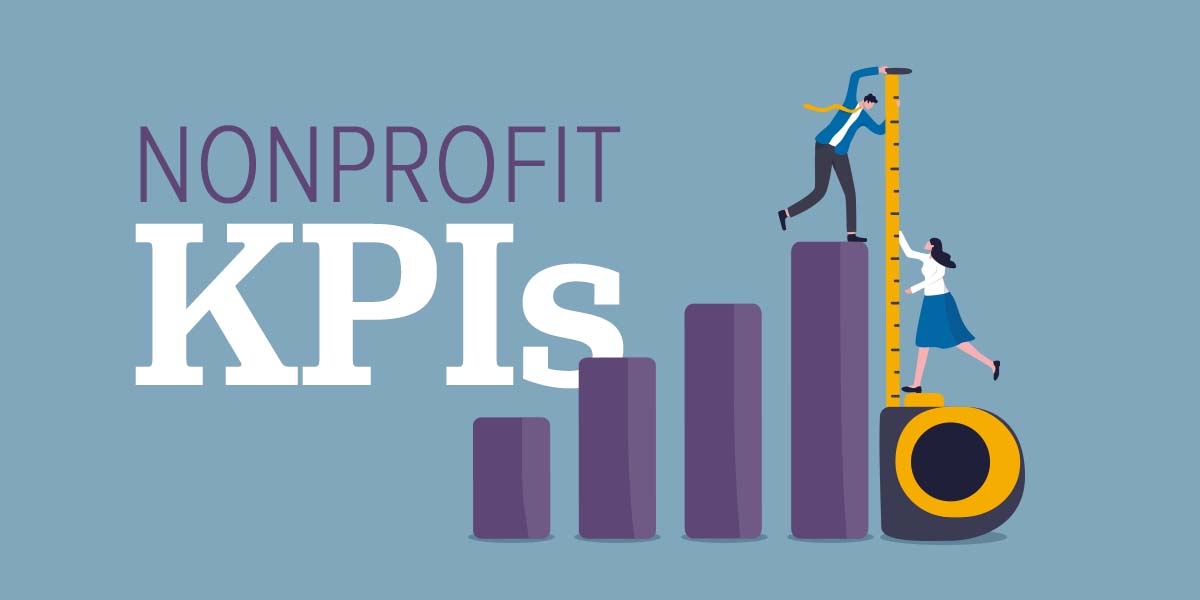Nonprofit KPIs – A Guide to Getting Started
Lisa Hirst Carnes | May 2023

Over the last year-plus, we’ve talked to clients about Google sunsetting Google Analytics 3 (aka Universal Analytics) on July 1, 2023. You know when you have something big like a trip coming up in the distant future, and then suddenly it’s here? That’s what this feels like. It’s coming up fast! Psst…if you still need help migrating to GA4, contact us!
While migrating properties to GA4, we’ve also been updating our web analytics dashboards to make them more comprehensive and customized and report the metrics our clients care about. BTW – if Looker Studio has you scratching your head with confusion, we can help.
The first part of our process involves identifying KPIs (key performance indicators). This post covers how to use KPIs to help guide your strategy, KPI best practices, and the top KPIs to track.
But, before discussing KPI strategy, let’s start with the basics.
KPI Basics
KPIs are Key Performance Indicators. They measure the performance of a business, organization, or individual against specific metrics. For example, an organization may use KPIs to track donations or volunteer sign-ups.
KPIs can help organizations identify areas for improvement and measure progress toward goals. Monitoring KPIs helps organizations understand their current position and set future objectives.
KPIs in the Wild
At ArcStone, we like our KPIs. Every Monday, we review our numbers from the previous week. Our KPIs range from proposals sent out, and sales made to support tickets closed and hours logged. Tracking these KPIs allows us to see how well we do over time.
KPI Best Practices
Like most things, following best practices is vital and impacts your success.
First, (this is critical!) identify the right KPIs and determine which are most relevant to your goals. Your KPIs should align with your organization’s goals.
Here are some of the key best practices when it comes to KPIs:
Establish Clear Targets
Organizations must establish clear targets for each KPI. Each KPI should be measurable and achievable to track progress and measure success. Opt for SMART goals.
Regularly Monitor Progress
Track all KPIs to ensure that they accurately measure progress. Tracking your progress will help to gain insight and identify areas for improvement. Customized dashboards help make reviewing your progress simple.
Measure Impact of Changes
Track and measure any changes made to the organization to see if they impact the KPIs. This could be anything from a new approach to customer service or a change in process. Measuring the effect of a change can help you make informed decisions in the future.
Leverage Technology
Technology is essential for tracking KPIs. Use analytics solutions to collect, store and analyze data from sources. For your nonprofit, this may mean using Google Analytics, data from your email marketing platform, CRM, fundraising platform, and more.
Common KPI Mistakes
When it comes to key performance indicators, there are unlimited possibilities. Unfortunately, with so many options, it’s easy to make mistakes.
Here are some of the most common KPI mistakes.
Not Tracking the Right KPIs
This is the biggest, most common mistake! To establish the right KPIs, assess your goals and objectives. Then, consider what you want to achieve and develop KPIs that align with those objectives.
No Clear Roles or Responsibilities
Another mistake is not knowing who will handle measuring and evaluating KPIs. Assign a specific team member or department to track KPIs. This will ensure that the KPIs are monitored.
Not Reviewing KPIs Regularly
Top 5 KPIs for Nonprofit Organizations
Fundraising ROI
Fundraising is not fun, and most times it isn’t free. That’s why you must track your fundraising ROI. In doing so, you’ll understand what campaigns are more effective than others.
Calculating your fundraising ROI is an easy formula.
((Fundraiser income – fundraiser expense) / fundraiser expense) x 100 – Your Fundraiser ROI.
So, for example,
$100,000 (fundraiser income) – $60,000 (fundraiser expense) = $40,000
$40,000 / $60,000 = .667
.667 x 100 = 66.7% ROI
Donation Growth
Your donation growth measures how much donation revenue you gain year-over-year.
(($ total of the most recent year’s donations – $ total of prior year’s donations) / $ total of prior year’s donations) × 100 = Donation Growth Rate
So, for example,
$590,000 – $490,00 = $100,000
$100,00 / $490,000 = .20 x 100 = 20.41% Donation Growth Rate
Website Donation Conversions by Channel
Understanding your top-performing channels will allow you to spend your marketing dollars wisely.
Find this information by looking at Source / Medium data in Google Analytics.
Website Users and Engagement
Staff / Volunteer Retention Rate
Employees and volunteers are the backbone of any organization. This metric looks at the rate at which employees and volunteers leave an organization within a specific timeframe. For a small organization, this might feel like overkill, but tracking retention offers a valuable perspective over time.
If you need help identifying your organization’s KPIs or setting up a report dashboard so they’re easy to review, contact us today!

